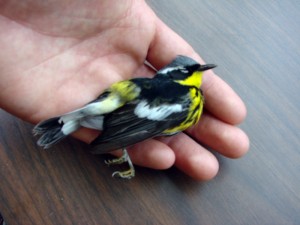Here are some things that you can do to help birds. Life is not easy for wild birds — especially in cities.
1. Keep pet cats indoors. Cats kill millions of birds each year. Ground-feeding and ground-nesting birds and fledglings are at greatest risk of cats. Feeder birds are also easy prey!
2. Use alternatives to chemical pesticides. These can be deadly to birds! Look for alternatives when possible, such as biological controls for unwanted insects and vegetation.

You can reduce bird deaths by moving your feeders CLOSER to your windows! When feeders are placed within three feet of a window (or more than 30 feet away) the number of window strike deaths is much lower. When feeders are close to a window, a bird leaving the feeder isn’t going fast enough to do harm if it hits the window.
If birds continue to strike your window attach netting to the outside of the window to cushion the impact. Deer netting (the kind used to keep deer from eating plants in your yard) works nicely. Learn more here.
4. Turn off the lights! Migratory birds collide with windows of lit buildings at night. Turn off lights whenever possible, especially during migrations. A great website that addresses migratory bird collisions with windows of lit buildings at night is Fatal Light Awareness.
